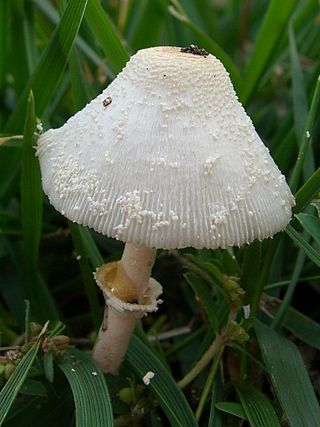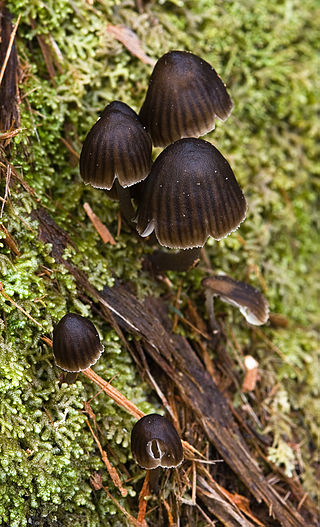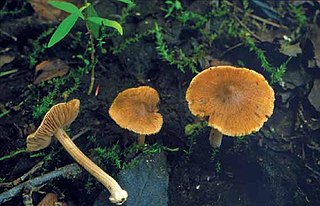
Leucocoprinus cepistipes, is a species of fungus in the family Agaricaceae. It is typically found on wood debris, such as wood chips but may also grow in potted plants or greenhouses. Typical characteristics include a fine-scaled bell-shaped cap, a partial veil, and a tendency to bruise a yellow to brown when handled.

Mycena nargan, commonly known as the Nargan's bonnet, is a species of fungus in the family Mycenaceae, and the sole member of the section Nargan in the genus Mycena. Reported as a new species in 1995, it is known predominantly from Southern Australia. The saprobic fungus produces mushrooms that grow on well-decayed wood, often on the underside of wood lying in litter. The dark chestnut-coloured caps are covered with white, easily removed scales, and reach diameters of up to 2 cm (0.8 in) wide. The pale, slender stems are up to 5 cm (2.0 in) long and have white scales at the base. On the underside of the cap, the cream-coloured gills are widely spaced and bluntly attached to the stem. The edibility of the mushroom is unknown.

Inocybe godeyi is a species of Inocybaceae fungus found in Europe. The species produces mushrooms with cone-shaped caps up to 5 cm (2 in) in diameter. The caps are cream, becoming browner, but they bruise red. The stem is up to 6 cm (2 in) long, and has a "bulb" at the base. The white flesh has a strong smell and an acrid taste. The mushrooms can be found on forest floors in autumn months; the species forms an ectomycorrhizal relationship to surrounding trees, favouring beech. I. godeyi is known to be poisonous, containing muscarine compounds, and consumption of the mushrooms can lead to SLUDGE syndrome. The species is sometimes mistaken for the deadly I. erubescens.

Inocybe saliceticola is a fungus found in moist habitats in the Nordic countries. The species produces brown mushrooms with caps of varying shapes up to 40 millimetres (1.6 in) across, and tall, thin stems up to 62 mm (2.4 in) long. At the base of the stem is a large and well-defined "bulb". The species produces unusually shaped, irregular spores, each with a few thick protrusions. This feature helps differentiate it from other species that would otherwise be similar in appearance and habit.
Leucocoprinus straminellus is a species of mushroom producing fungus in the family Agaricaceae. Like other Leucocoprinus species it may have originated in a tropical climate but now finds a home in plant pots, greenhouses and compost piles in many countries. Leucocoprinus straminellus is described as being similar to the more commonly known Leucocoprinus birnbaumii but it is smaller and a lighter shade of yellow with smaller spores that lack a germ pore. It is also described as being superficially similar to Leucocoprinus fragilissimus but slightly more robust with flesh that is less translucent.

Leucoagaricus meleagris is a species of fungus in the family Agaricaceae.

Cystoagaricus strobilomyces is a species of mushroom producing fungus in the family Psathyrellaceae and the type species of the Cystoagaricus genus
Leucocoprinus cygneus is a species of mushroom producing fungus in the family Agaricaceae.
Leucocoprinus bakeri is a species of mushroom producing fungus in the family Agaricaceae.

Macrolepiota zeyheri is a species of mushroom producing fungus in the family Agaricaceae. In the Kilendu dialect it is known as djilo and in the Kilur dialect it is called n'volo mighom.
Leucocoprinus martinicensis is a species of mushroom producing fungus in the family Agaricaceae.
Leucocoprinus fuligineopunctatus is a species of mushroom producing fungus in the family Agaricaceae.
Leucoagaricus tricolor is a species of mushroom producing fungus in the family Agaricaceae.
Cystolepiota albogilva is a species of mushroom producing fungus in the family Agaricaceae.
Cystolepiota potassiovirens is a species of mushroom producing fungus in the family Agaricaceae.
Hiatulopsis aureoflava is a species of mushroom producing fungus in the family Agaricaceae.
Cyptotrama nivea also known as Cyptotrama niveum is a species of mushroom producing fungus in the family Agaricaceae.
Cyptotrama pauper also known as Cyptotrama pauperum is a species of mushroom producing fungus in the family Agaricaceae.
Leucoagaricus griseosquamosus is a species of mushroom-producing fungus in the family Agaricaceae.
Leucocoprinus minutulus is a species of mushroom producing fungus in the family Agaricaceae.






